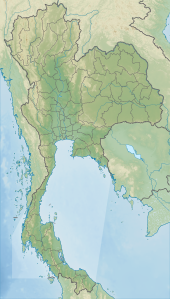| Phu Pha Thoep National Park | |
|---|---|
| อุทยานแห่งชาติภูผาเทิบ | |
| IUCN category II (national park) | |
 The park is home to unusual rock formations The park is home to unusual rock formations | |
 | |
| Location | Mukdahan Province, Thailand |
| Nearest city | Mukdahan |
| Coordinates | 16°26′21″N 104°45′24″E / 16.43917°N 104.75667°E / 16.43917; 104.75667 |
| Area | 48 km (19 sq mi) |
| Visitors | 47,609 (in 2019) |
| Governing body | Department of National Parks, Wildlife and Plant Conservation |
Phu Pha Thoep National Park (Thai: อุทยานแห่งชาติภูผาเทิบ), formerly known as Mukdahan National Park (Thai: อุทยานแห่งชาติมุกดาหาร), is a national park in Mukdahan Province, Thailand. This park, one of the country's smallest national parks, is home to unusual rock formations and a cave with ancient hand paintings.
Geography
Phu Pha Thoep National Park is located about 17 kilometres (11 mi) south of Mukdahan in Mueang and Don Tan districts. The park's area is 30,245 rai ~ 48 square kilometres (19 sq mi). The highest point is Phu Jongsi peak at 420 metres (1,400 ft).
History
Phu Pha Thoep National Park is home to a cave with hand paintings estimated to be 3,000 to 5,000 years old. The cave name, Tham Fa Mue Daeng, means "red hand", referring to the red colour of the paintings.
Attractions
Phu Tam Pra is a mainly seasonal waterfall. Above this waterfall is a cave grotto housing a three-foot wide Buddha image along with hundreds of smaller wooden Buddha images and animal models.
The park's namesake mountain Phu Pha Thoep hosts a complex of rocks in eroded formations thought to resemble mushrooms, temples, swans etc. The viewpoint atop Phu Mano affords views of Mukdahan city, the Mekong river and neighbouring Laos.
Flora and fauna
The park features forest types including mixed and deciduous. Tree species include Afzelia xylocarpa, Anisoptera costata, Dalbergia cochinchinensis, Dalbergia oliveri, Irvingia malayana, Lagerstroemia calyculata, Pterocarpus macrocarpus, Shorea roxburghii, Shorea obtusa, Shorea siamensis, Toona ciliata and Dalbergia obtusifolia. Various species of Dillenia, Barringtonia and Cratoxylum are also present.
Animals in the park include northern pig-tailed macaque, sambar deer, golden jackal, common palm civet, northern red muntjac (Muntiacus muntjak vaginalis) and wild boar. The park's many birds include junglefowl, green peafowl and pheasant. In 2005, specimens of a new frog species, Fejervarya triora, were discovered in the park.
See also
References
- ^ "Introducing Phu Pha Thoep National Park". Lonely Planet. Retrieved 4 April 2014.
- "ข้อมูลพื้นที่อุทยานแห่งชาติ ที่ประกาศในราชกิจจานุบกษา 133 แห่ง" [National Park Area Information published in the 133 Government Gazettes]. Department of National Parks, Wildlife and Plant Conservation (in Thai). December 2020. Retrieved 1 November 2022, no 59
{{cite web}}: CS1 maint: postscript (link) - ^ "Phu Pha Turm National Park". Department of National Parks (Thailand). Archived from the original on 10 November 2013. Retrieved 4 April 2014.
- ^ National Parks in Thailand (PDF). Department of National Parks (Thailand). 2015. p. 168. ISBN 978-6-1631-6240-3. Archived from the original (PDF) on 15 February 2017.
- Chuaynkern, Yodchaiy; Salangsingha, Nakorn; Makchai, Sunchai; Inthara, Chantip; Duengkae, Prateep (2009). "Fejervarya triora (Amphibia, Ranidae): first description of the adult male and recent distribution records". Alytes. 27 (1). International Society for the Study and Conservation of Amphibians: 13–24. Retrieved 13 June 2017.